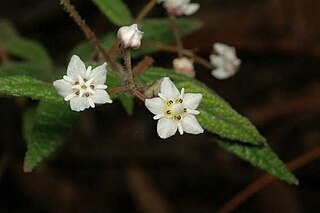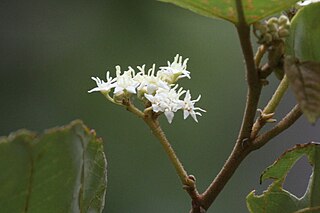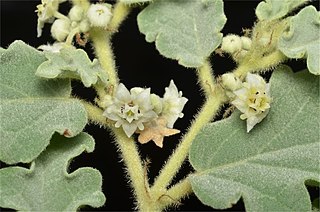
Commersonia amystia is a species of flowering plant in the family Malvaceae and endemic to eastern Australia. It is a dwarf shrub with narrow egg-shaped leaves that are densely covered with star-like hairs on the lower surface, and has flowers with five white sepals that turn pink as they age, and five smaller white petals.
Sannantha angusta is a species of flowering plant in the family Myrtaceae, and is endemic to eastern Australia. It has scaly to fibrous bark, narrowly lance-shaped to linear leaves and white flowers, and usually grows in forest on rocky hillsides. It was previously known as Babingtonia angusta, and has been cultivated as Baeckea sp. 'Clarence River'.
Commersonia parviflora, commonly known as small flowered rulingia, is a species of flowering plant in the family Malvaceae and is endemic to the south of Western Australia. It is a low, prostrate or dense shrub with wrinkled, egg-shaped leaves with rounded teeth on the edges, and clusters of small, white flowers.

Commersonia prostrata, commonly known as dwarf kerrawang, is a species of flowering plant in the family Malvaceae and endemic to eastern continental Australia. It is a prostrate shrub with trailing branches, egg-shaped leaves, the lower surface densely covered with star-like hairs, white, petal-like sepals, and smaller, pinkish petals.

Commersonia rugosa is a species of flowering plant in the family Malvaceae and endemic to New South Wales. It is an open, straggly shrub with linear to narrowly egg-shaped leaves with irregular teeth or lobes on the edges, and white flowers in clusters of 3 to 15.

Commersonia macrostipulata is a species of flowering plant in the family Malvaceae and is endemic to Queensland. It is a shrub or tree with egg-shaped leaves that are slightly serrated on the edges, flowers with five cream-coloured to white sepals and bristly fruit.
Commersonia obliqua is a species of flowering plant in the family Malvaceae and is endemic to Vanuatu. It is a shrub or tree with lance-shaped leaves and white flowers.
Androcalva aphrix is a species of flowering plant in the family Malvaceae and is endemic to the south-west of Western Australia. It is a dwarf, prostrate, hairy shrub with clusters of 14 or more pink or white flowers.
Androcalva argentea is a species of flowering plant in the family Malvaceae and is endemic to Queensland. It is a tall shrub that forms suckers from rhizomes and has silvery branchlets and leaves, the leaves egg-shaped with wavy edges and serrated, and dense clusters of 10 to 30 white to cream-coloured flowers.
Androcalva beeronensis is a species of flowering plant in the family Malvaceae and is endemic to Queensland. It is a shrub that forms suckers from rhizomes and has branchlets and leaves covered with soft, golden hairs, the leaves egg-shaped to lance-shaped with toothed edges, and clusters of 9 to 24 cream-coloured to white flowers.
Androcalva bivillosa is a species of flowering plant in the family Malvaceae and is endemic to the south-west of Western Australia. It is a prostrate, spreading shrub with clusters of 3 to 9 white to pink flowers.

Androcalva crispa, commonly known as crisped leaf commersonia, is a species of flowering plant in the family Malvaceae and is endemic to the south-west of Western Australia. It is a prostrate shrub that forms suckers from rhizomes and has densely new growth, clusters of lobed, egg-shaped or oblong leaves with wavy, serrated edges, and groups of white and pinkish-purple flowers.
Androcalva incilis is a species of flowering plant in the family Malvaceae and is endemic to the south-west of Western Australia. It is a prostrate shrub with dark green, narrowly wedge-shaped to narrowly oblong leaves, and crowded heads of 8 to 12 deep pink flowers.
Androcalva inglewoodensis is a species of flowering plant in the family Malvaceae and is endemic to south-eastern Queensland. It is a spreading, prostrate shrub that has hairy young branchlets, egg-shaped to elliptic leaves with irregularly serrated edges, and small groups of white to cream-coloured flowers.

Androcalva johnsonii is a species of flowering plant in the family Malvaceae and is endemic to central Queensland. It is a low, spreading shrub that has hairy young branches, narrowly egg-shaped or oblong leaves with rounded teeth, and small groups of white to pale pink flowers.

Androcalva leichhardtii is a species of flowering plant in the family Malvaceae and is endemic to central Queensland. It is a small shrub with hairy new growth, wrinkled, egg-shaped to lance-shaped leaves with irregular serrations on the edges, and small groups of yellow flowers.
Androcalva leiperi, also known as Leiper's commersonia, is a species of flowering plant in the family Malvaceae and is endemic to a restricted part of south-east Queensland. It is an erect or prostrate shrub that has brown bark, lance-shaped leaves with 4 to 7 pairs of rounded serrations on the edges, and groups of 3 to 12 white flowers.

Androcalva melanopetala is a species of flowering plant in the family Malvaceae and is endemic to southern inland Western Australia. It is a sometimes prostrate shrub that has densely hairy new growth, egg-shaped to elliptic leaves with rounded teeth on the edges, and clusters of white or cream-coloured and pink to red flowers.

Androcalva multiloba is a species of flowering plant in the family Malvaceae and is endemic to the Eyre Peninsula of South Australia. It is a dwarf shrub with densely hairy, irregularly serrated, egg-shaped leaves, and up to 5 white and red flowers arranged opposite leaf axils or on the ends of branches.
Androcalva pearnii is a species of flowering plant in the family Malvaceae and is endemic to the Blackdown Tableland National Park in eastern Queensland. It is shrub that forms suckers and has hairy new growth, wavy, oblong to elliptic leaves with rounded lobes on the edges, and groups of 3 to 8 white and cream-coloured to pale green flowers.









